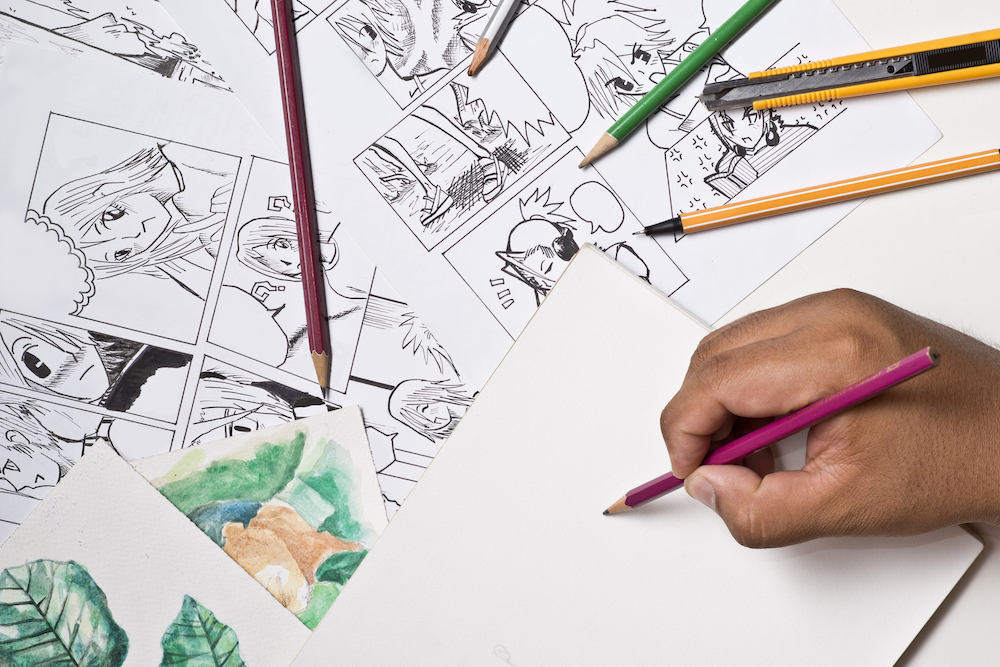Artist’s Step-by-Step Guide to Drawing Comics

No matter your age, comic books and comic drawings are always a great source of entertainment. Growing up you may have been engrossed by the classic DC or Marvel Comics, or you eagerly await the daily comic strip in your newspaper for a good laugh at the amusing stories and pictures. If you’ve ever thought about trying your hand at creating your own comic but don’t know where to start, you are at the right spot!
Drawing comics is easy and fun to do. All you need is an idea and some time to sit down and get creative! Learn how to draw comics with us.
Related Categories
- Drawing & Illustration
- Pencils
- Coloured Pencils
- Watercolour Pencils
- Sketching Pencils
- Pastel Pencils
- Pens & Markers
- Drawing Pens & Markers
Five steps to creating your own comic
1. Develop ideas
All great pieces of art start from a great idea. This is the time to begin brainstorming and researching character and story ideas for your comic. The best way to do this is to have a notepad or journal with you and to start jotting down any ideas that come into your head. For inspiration, try flicking through existing comics or graphic novels and get a feel for the style you’d like to emulate. A quick Google search will turn up heaps of comic ideas and all sorts of characters and stories that you can become inspired by. Remember, this is your comic so don’t get too caught up following what’s ‘trendy’ or popular. Inspiration can hit you at any time, which is why it’s important to carry your journal around wherever you go and keep it beside your bed. Many artists report coming up with their best ideas while in the early stages of sleep!
During this stage, you can begin coming up with your characters. There is no right or wrong way to develop comic book characters. You may have been carrying around your character idea for a while now or you may have yet to come up with one. If it’s the latter, consider creating a ‘character profile’. It’s here you can start ‘fleshing out’ your character by coming up with their gender, name, their personality trait, their strengths and weaknesses, what they like to eat, etc.
The more detailed you get in creating your character, easier it will be to come up with a story direction for your comic.
2. Create your story
Once you have an idea of your characters and a loose idea of the story you want to tell, the next step is to create a storyboard. This is a good time to begin roughly sketching your comic and the structure of your story. You don’t need to have every panel figured out at this stage. But be sure to have a good idea of the beginning, middle, and end of your story as this will make it easier to fill in the gaps. Some people find it better to come up with a script and then start sketching, while others find sketching and then developing the script as they go along works best for them.
For beginners, it’s suggested to write a script from start to finish. You can even do this in dot-point form if you don’t want to write full paragraphs. You just need a basic guide to go off. Once you have the full story written in long-form or in dot-point form, you can then start sketching out the comic to follow the story. Most artists like to follow the traditional single strip layout (two to four panels in a single strip) when it comes to drawing comics, but you can also experiment with a single frame comic or a comic page.
Here are some points to consider when creating your story:
- Establish the genre of your comic. Is it humorous? Serious? Action-oriented?
- What is the goal of the main character? Who are their enemies or who stands in the way of achieving this goal?
- Where will your comic be set? At a park, on a spaceship, in a city?
- Make sure to have a distinct beginning, middle, and end
3. Start sketching
This is the fun part. Now that you have your script figured out, it’s time to begin the first draft of your comic. Get your notepad and start ruling out your panels and strips. The best way to do this is to get a grey lead pencil and ruler and measure out your strip. You can easily erase and change lines this way. The most common strip size that cartoonists use for their strips is a 4 x 13 inches horizontal strip. However, you really are free to size it any way you like as well as include square panels followed by longer horizontal panels depending on the detail needed in each scene.
Sketching your comic initially with a sketching pencil allows you to erase any mistakes or make any changes as you go along. At this stage you don’t have to be perfect; just get everything down first before perfecting it during the inking and colouring stage.
4. Draw your comic
Now that your rough draft is sketched, it’s time for the inking and colouring. For this step, you will need the right tools. First, a Copic Multiliner for illustrating and also a set of coloured Copic Markers for colouring-in your comic strip. These markers come with a variety of nibs to create different types of strokes; from fine detailed lines to wider fills.
Start your final copy by drawing your comic from start to finish using a light pencil. Once you’re satisfied, you can go over the pencil with your ink markers. When it comes to colour selection, it’s a good idea to keep it consistent throughout. Too much colour in every panel can become confusing and may detract from the story or dialogue. Think about comics such as Batman; throughout the story there’s a consistent colour scheme. This sets the tone or ‘feel’ of your comic and can be a powerful way to convey emotion or action in the story.
If you’ve added lettering to your comic to portray sound-effects such as “pow!” or “smash!” make sure the colour doesn’t fade into the background by ensuring the font and the colour selection is powerful and is the first thing you see.
5. Publish your comic
Once your comic is done, it’s time to scan it to your computer. Once uploaded, you can tweak and add things on Photoshop or manipulate the colours to be more vibrant. Be sure to scan your comic at 600 DPI (dots per inch) to keep the lines looking sharp.
If you aren’t a fan of drawing your own lettering and fonts, then you can use a computer program to add these onto your comic. The biggest collection of comic book fonts can be found at Blambot. You can find a large range of both free and paid fonts to download and insert into your comic strip. Once you’ve finished editing, now is the time to share your creation with the world!
Here are some ways that you can publish your comic:
Once your comic is done, it’s time to scan it to your computer. Once uploaded, you can tweak and add things on Photoshop or manipulate the colours to be more vibrant. Be sure to scan your comic at 600 DPI (dots per inch) to keep the lines looking sharp.
If you aren’t a fan of drawing your own lettering and fonts, then you can use a computer program to add these onto your comic. The biggest collection of comic book fonts can be found at Blambot. You can find a large range of both free and paid fonts to download and insert into your comic strip. Once you’ve finished editing, now is the time to share your creation with the world!
Here are some ways that you can publish your comic:
- Upload and share it on social media (Facebook, Instagram, Twitter, etc.) or using an online service such as PhotoBucket, Pinterest, or ImageShack.
- Create a website to showcase your comics
- Send your comic to a publisher
- Share your comic with others on a website such as BuzzComic
Get cartooning and create the ultimate comic today!
Creating your own comic is a fun way to be creative and to express your ideas and stories in a unique artform. Hopefully you've learnt a thing or two about how to draw comics. If you are looking for the right tools and accessories to start drawing a comic, check out our online store here.
Related Articles
